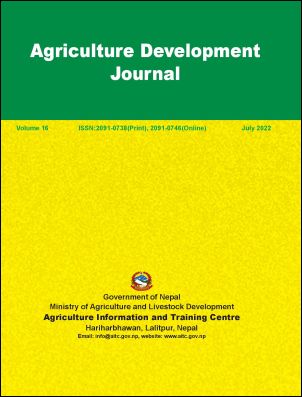Nutrient Management Practice for Conservation and Conventional Agriculture Practices on Rice Based System at Central Terai of Nepal
DOI:
https://doi.org/10.3126/adj.v16i1.51616Keywords:
Conservation agriculture, Green manuring, Nutrient expert, Residue managementAbstract
A field experiment was conducted to evaluate the effect of inventive nutrient management practices on the system productivity and profitability of rice-wheat and maize in the rice-based cropping system under conservation agriculture and conventional tillage at Agriculture and Forestry University (AFU), Rampur, Chitwan, Nepal during 2018 - 2019.The experiment was executed in the field in split-split design (for rice), and split plot design (both for wheat and maize) with three replications which included two cropping system (rice-wheat and rice-maize) as main plot treatments, two establishment methods (conservation agriculture and conventional agriculture) as sub plots and four nutrient management practices (100% Recommended dose of fertilizer (RDF), Residue (5 t ha-1) + 75% RDF, Nutrient Expert (NE) dose, brown/green manuring (BM/GM) + 75% RDF) as sub-sub plot treatments. The data on yield and economics were recorded and analyzed by R studio. The yield of wheat and maize were converted into rice equivalent yield (REY) from which system yield was calculated. The research revealed that the rice-maize system had significantly higher REY (12.21 t ha-1), net returns (163.10 thousand NRs. ha-1) over rice-wheat system (8.61 t ha-1 and 68.09 thousand NRs. ha-1, respectively) whereas the crop establishment methods and nutrient management practices have no influence on the REY of the system. NE dose, Residue +75% RDF and 100% RDF produced similar REY. The rice grain yield was found higher (5.28 t ha-1) for conventional tillage than under CA (4.52 t ha-1) however the maize and wheat yield was not affected by the crop establishment methods. Under both establishment methods, NE dose performed better for all crops but NE dose and green manuring produced higher yields under conventional tillage for rice. The residue +75% RDF performed better than 100% RDF for maize and wheat. Rice-maize cropping system was more productive and eventually more profitable than rice-maize cropping system and the under both establishment methods, better yield can be obtained using NE dose, green manuring and residues in the fields with the saving of 25% RDF applied for each crops.




